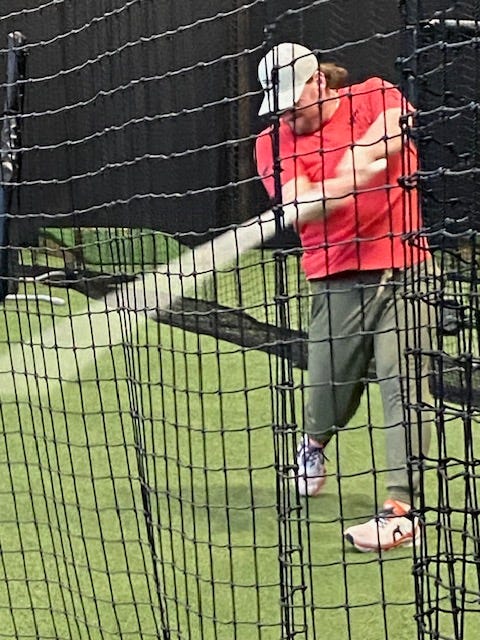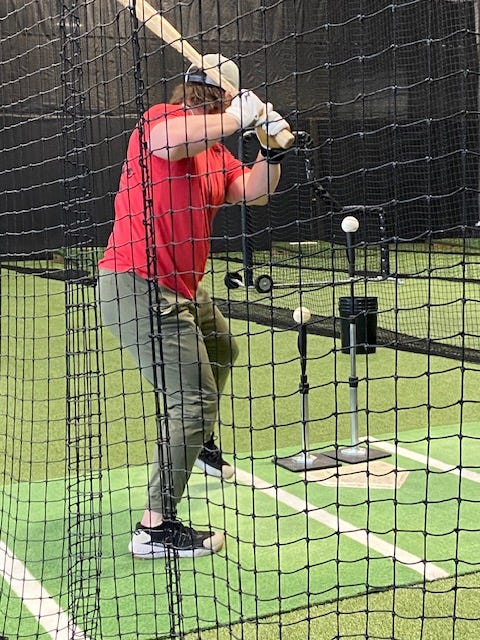The off-season 'labor pains' of hitting
Nogo's discipline, hard work and stinging bat has kept him playing
There were a lot of memorable lines in Jim Bouton’s classic “Ball Four,” his hilarious, diary-like account of his season with the expansion Seattle Pilots in 1969. but one that sticks with me came from noted pitching coach Johnny Sain. Sain was counseling Bouton, a continual complainer/whiner, about making too much of a stink for his own good.
“The world doesn’t want to hear the labor pains,” Sain said. “It just wants to see the baby.”
For yet another spring, my son John is getting himself ready for another baseball season. He’s been training this off-season in Eden, Utah, working out with the University of Utah and trying to fine-tune that sweet swing for his upcoming baseball campaign.
You might think he’s swung enough already across all levels; three seasons at Florida State, parts of two seasons in the major leagues and ten in the minors as well as trips to the Dominican Republic and Mexico.
He posted a .346 average for the Sioux City Explorers in the American Association last season with 18 HR, 72 RBI, 29 doubles, 71 walks, 30 whiffs and an impressive 1.014 OPS (On-base, plus slugging). He nearly won the batting title with a 3 HR performance in the regular-season finale.
Through 1,262 games, 4,254 at bats, 1,202 hits, 231 doubles, 108 home runs, 704 RBI, 623 walks and only 571 strikeouts, a .382 on-base percentage, John’s compiled a lifetime .283 average, pretty sporty stretching over 13 seasons (Baseball Reference includes his three years at FSU.)
As a youngster, he was blessed with great hand-eye coordination and always put up amazing averages (.714 in Advanced Play, a record-setting 30-for-39 .769) in a championship week at Cooperstown’s Dreams Park) but as someone who has stood on the other side of a screen for more batting practice throws than I could — or would dare to —count, his on-field success came because of dedicated, relentless hard work. For years, we’d start hitting on Christmas Day, right after we’d opened our presents. And continued on, often, even after the season started. Precious Father-Son time.
He’s had a chance to play baseball for a lot of years, for many major-league organizations (The A’s, Cardinals, Pirates, Nationals, Braves, Giants), played winter ball and his work ethic, I think, is the reason he’s been able to extend his career, way longer than many 34th round draft picks usually do.
In the minor leagues, one reason he was able to keep advancing, hitting better at each level. The higher he went, the better he hit, even after arriving in Triple A, the manager telling him he really didn’t have a position, that he’d try to work him in here and there. Five games later, he was hitting third.
. He has always had a great sense of the strike zone, something drummed into him by Ted Williams’ “The Science Of Hitting” and dear old Dad. And he’s lived his baseball life by trying to make his every at bat count.
As you’ve seen, the major leagues pay absolutely no attention to strikeouts. Kyle Schwarber. for example, had 215 strikeouts in 2023 and there are dozens of players every year who’ll have well over 100 for several seasons now and baseball is OK with that. John has had way more walks than strikeouts — 71 walks in 100 games, just 30 strikeouts, one of only three players in all professional baseball to achieve that more walks than whiffs ratio.
Those of us who are tired of the HR-Strikeout-Walk game we’re subjected to most evenings remain hopeful the game goes back to when each at bat mattered and strikeouts were something you tried to avoid at all costs. That may never happen.
In a lot of ways, John is a throwback to the way the game used to be played, where you took your walks, hit behind the runner, made sure you got the ball to the outfield with a man on third with one out. That’s how I learned the game and how I taught it to him. It still plays, if you ask me.
But with the technological advances — well, let’s call them “shifts” we don’t know for sure that they’ve really advanced anything yet — he’s had to adapt and he has. Which is why I wanted to show you what he’s been up to this off-season.
And, as you’ll see from the photos and video clips, he’s always been willing to try something different, some unusual approach to refining that swing, trying to get a little more bat speed, more power, better bat control.
John uses a long piece of PVC plumbing pipe to pick up bat speed.
In the old days of baseball — when I played — you used a metal donut you fitted over the end of your bat. Some players swung two bats in the on-deck circle. Some players have even swung a sledge hammer. The idea here is to really whip the bat through the strike zone. Bat speed + Good Contact = Distance.
The idea here, using tees of differing heights is to try to make certain you stay through the baseball which you can tell by where the ball travels. John had a coach who always used to say “Follow the flight of the ball. That tells you all you need to know.” If you’re yanking the ball to one side or the other, that’s telling you plenty.
John’s not doing his Pete Gray impression — he was the former big-leaguer who played in the majors but only had one arm. Instead, John is choking up on the bat and swinging one-armed, trying to consistently hit the ball with the sweet part of the bat.
Here, using the latest technology (you can see the knob at the end of his bat), John again is working on bat speed, measuring what sort of speed the bat is at when it makes contact in the zone. The major-league average is 75. John is measuring the bat velocity of each and every swing. That’s how technical and specific each swing is. The old days of Dad bringing a bucket of balls and trying to hide behind an “L” screen for 50 to 100 swings are over. (My right arm says ‘Thank you.”) But we had a lot of time to talk. And work together to get him where he wanted to be. It was so important.
A drill for the youngsters!
John has moved past this drill, of course. With 4,254 at bats, it’s now part of his muscle memory. But for many years, we’d open our batting cage sessions with this drill because it makes you use your hands. You need your hands to hit.
Spread your legs as wide as you can and do soft toss or flips. Really focus on using your hands — not your arms — to square up the baseballs as best you can. Maybe 15 or 20 flips might do it. Then, when you go to start taking BP, you’ll notice the difference — or you should — in your swing. It’s all in your hands…
Ever since he caught a fly ball on Father’s Day all those years ago, John’s wanted to play baseball and as he told me once, “I don’t want to be good, I want to be great.” And to get to the major leagues, unlike so many of the great players he watched and played with that didn’t quite get that far, he did. That is special, unforgettable.
The game has taken him all over this country and us, too. In a few weeks, it’ll be starting again. I wanted my readers out there to get a sense of all that you don’t see that goes into the making of a professional hitter. A damn good one, too.
John’s track record: From Florida State to the Majors to the American Association







Wonderful to see how John trains and gets ready for the new season. I am enjoying the reading of your great new Baseball book DIAMOND DUELS, and just passed the part where being in condition ( after the off season) has always been stressed. What a lot work went into this book, and so well written, a Great Read!!!